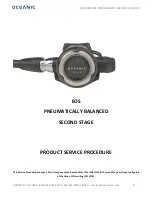
Programming
15/24
7.
Device parameter
The
IAKV
-2VR4C
has a number of unit parameters with which the function of the
indicator can be adjusted to the relevant measuring tasks. Because of the large number
of these settings and the limited possibility of displaying them on the 7-segment
display, the parameters have been given consecutive numbers.
7.1.1.
Measuring input PN0
One of the aspects in the basic configuration is the desired measuring input, which consists
of the terminal selection and the relevant factory or sensor calibration.
7.1.2.
Skaling PN1 and PN2
The two program numbers 1 and 2 are used to scale the indication. With these two
parameters the end value and start value are parameterised. If sensor calibration has been
selected via PN0 = 0, then the current for the relevant sensor signal must be applied during
programming. Otherwise, a simple allocation of the selected input configuration will be
made. For example, at PN0 = 3, which corresponds to a standard signal input 0…10 V, the
value saved under PN1 will be indicated at 10 V, and the value saved under PN2 will be
indicated at 0 V.
7.1.3.
Decimal point PN3
By changing this parameter the number of places shown after the decimal point in the
display is changed. This parameter has no influence on the scaling of the indication value,
only on the position of the decimal point in the display.
7.1.4.
Offset shift PN5
With this parameter it is possible to carry out a parallel shift of the parameterised
characteristic line. This may be necessary, if for example a pressure transmitter ages over
the course of time, giving rise to a shift in the zero point. With the parallel shift the
transmitter can be adjusted back to the zero point. Another application is to parameterise a
certain tank level to zero and have any deviation from this level displayed.
7.1.5.
Zero point suppression PN10
Via the zero point suppression, an indication value window can be defined as zero. This
means, for example, that at PN10 = 10, all indication values between –10 … 10 are shown
in the display as zero. This function is intended to produce a reliable zero indication at high
display resolution and low sensor accuracy around zero. This could be, for example, the
rpm of an engine for which a zero would be expected in the display when standing still.
7.1.6.
Indication time PN13
The indication time is the interval at which the display is updated. The longer the time
between two indication cycles, the calmer the display. As a rule, the eye perceives the
indication time of 1 s as very pleasant. If the adjusted indication time is longer than the
adjusted measuring time, no averaging of the detected measuring values during the
indication time takes place. The display will be always refreshed with the newest detected
measuring value.










































